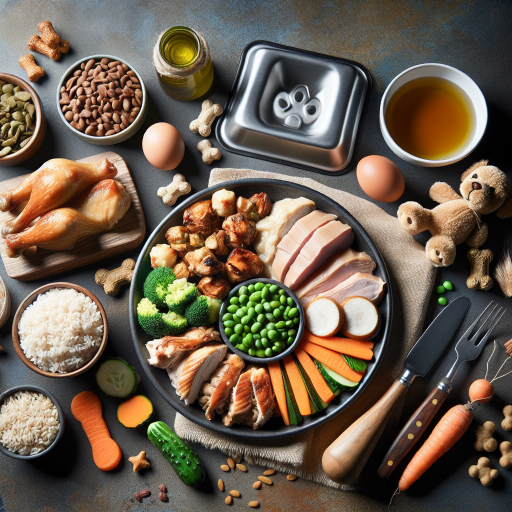Introduction to Cooked Food for Dogs
Hey there, pet parents! Are you tired of feeding your furry friend the same old dry kibble every day? Well, you’re in luck because today we’re going to talk about the benefits of cooked food for dogs! Cooking food for your dog can be a great way to provide them with a variety of nutrients and flavors that they might not get from commercial pet food.
Many pet owners are turning to cooked food for their dogs as a way to give them a fresh and wholesome diet. Whether you’re looking to add some extra nutrients to your dog’s diet or just want to spoil them with a homemade meal, cooking for your dog can be a fun and rewarding experience for both you and your furry friend.
While commercial pet food is convenient and formulated to meet your dog’s nutritional needs, some pet owners prefer to take a more hands-on approach to their dog’s diet. Cooking food for your dog allows you to control the ingredients and ensure that your dog is getting a balanced and healthy meal.
So, if you’re ready to get cooking for your canine companion, keep reading to learn more about the benefits of cooked food for dogs and how to get started in the kitchen!
The Benefits of Cooked Food for Dogs
Hey there, pet parents! If you’re looking to give your furry friend a healthy and delicious meal, cooked food might just be the answer. Cooking food for your dog can have numerous benefits that can contribute to their overall well-being. Let’s dive into some of the advantages of feeding your dog cooked meals:
- Improved Digestion: Cooking food for your dog can make it easier for them to digest. Certain ingredients, like vegetables and grains, can be more easily broken down when cooked, leading to better nutrient absorption and less digestive upset.
- Customizable Nutrition: When you cook for your dog, you have full control over the ingredients you use. This means you can tailor your dog’s meals to meet their specific dietary needs, whether they require more protein, fewer carbohydrates, or certain vitamins and minerals.
- Fresh and Flavorful: Cooking meals for your dog ensures that they are getting fresh, high-quality ingredients. You can also add natural flavors and seasonings to make their meals more appealing, which can encourage picky eaters to enjoy their food.
- Reduced Allergies: Some dogs may have allergies or sensitivities to certain ingredients in commercial dog food. By cooking for your dog, you can avoid these potential allergens and create meals that are safe and nourishing for your furry friend.
- Healthier Weight Management: Cooking for your dog allows you to control portion sizes and ingredients, which can be beneficial for weight management. You can incorporate more lean proteins, healthy fats, and complex carbohydrates to help your dog maintain a healthy weight.
Remember, it’s important to consult with your veterinarian before making any significant changes to your dog’s diet. They can provide guidance on the best ingredients and meal plans for your dog’s specific needs. Additionally, be sure to monitor your dog’s weight, energy levels, and overall health when transitioning to a cooked food diet to ensure that it’s benefiting them in the long run.
Cooking for your dog can be a fun and rewarding experience that strengthens the bond between you and your furry companion. By providing them with nutritious and delicious meals, you’re not only showing them love but also contributing to their health and well-being. So, grab your apron, gather some ingredients, and get ready to cook up something special for your four-legged friend!
Nutritional Considerations for Cooked Dog Food
So, you’ve decided to start preparing cooked food for your furry best friend – that’s fantastic! But before you dive into the world of homemade meals for your pup, it’s crucial to understand the nutritional considerations that come with it.
When cooking food for your dog, it’s essential to ensure that their diet is balanced and provides all the necessary nutrients they need to thrive. Dogs require a mix of protein, carbohydrates, fats, vitamins, and minerals to maintain optimal health and energy levels. Here are some key points to keep in mind when preparing cooked food for your canine companion:
1. Protein: Dogs are carnivores by nature, so protein should be a significant component of their diet. Protein sources can include lean meats like chicken, turkey, beef, and fish. It’s important to vary the protein sources to provide a range of amino acids essential for your dog’s overall health.
2. Carbohydrates: Carbohydrates are a crucial energy source for dogs. Common carbohydrate sources include rice, oats, sweet potatoes, and quinoa. It’s best to opt for whole grains and complex carbohydrates to ensure sustained energy levels for your pup.
3. Fats: Fats are essential for maintaining healthy skin and coat, as well as for providing energy. Healthy fat sources like salmon oil, coconut oil, and flaxseed oil can be added to your dog’s cooked meals in moderation.
4. Vitamins and Minerals: To ensure your dog receives all the necessary vitamins and minerals, consider adding a dog-safe multivitamin or incorporating a variety of fruits and vegetables into their meals. Leafy greens, carrots, blueberries, and apples are excellent options.
5. Portion Control: Just like humans, dogs need portion control to prevent obesity and maintain a healthy weight. Be mindful of the quantity of food you are serving to your dog, based on their size, activity level, and individual needs.
6. Consult with a Veterinarian: Before making any significant changes to your dog’s diet, it’s essential to consult with a veterinarian or a canine nutritionist. They can provide valuable guidance on creating a balanced diet tailored to your dog’s specific needs and health requirements.
By paying attention to these nutritional considerations and ensuring that your dog’s meals are well-balanced and varied, you can provide them with a healthy and delicious diet that will keep their tails wagging with joy! Remember, every dog is unique, so it’s essential to adjust their diet based on their individual needs and preferences.
Taking the time and effort to prepare cooked food for your dog can be a rewarding experience for both you and your furry companion. With the right balance of nutrients and ingredients, you can provide your dog with a diet that promotes their overall well-being and longevity. So, grab your apron and get cooking – your pup will thank you with endless love and slobbery kisses!
How to Prepare Cooked Food for Dogs
So, you’ve decided to start cooking for your furry friend – that’s paws-itively wonderful! But you might be wondering, “How do I even begin?” Don’t worry, we’ve got you covered with some helpful tips and tricks on preparing cooked food for dogs.
1. Consult with a Veterinary Nutritionist
Before embarking on your cooking journey, it’s essential to consult with a veterinary nutritionist. They can provide you with guidance on your dog’s specific dietary needs and help you create a balanced meal plan that meets all of their nutritional requirements.
2. Choose High-Quality Ingredients
When selecting ingredients for your dog’s meals, opt for high-quality, fresh ingredients that are safe for canine consumption. Avoid using any ingredients that are toxic to dogs, such as onions, garlic, grapes, and raisins.
3. Cook Thoroughly
Make sure to cook all ingredients thoroughly to prevent any foodborne illnesses. Avoid feeding your dog raw meats or eggs, as they can contain harmful bacteria that could make your pup sick.
4. Avoid Seasonings and Additives
While you may be tempted to add seasonings or flavorings to your dog’s food to make it more appealing, it’s best to avoid these additives. Dogs have sensitive stomachs, and certain seasonings like garlic or onion powder can be toxic to them.
5. Monitor Portion Sizes
It’s important to monitor your dog’s portion sizes to prevent overfeeding or underfeeding. Consult with your veterinarian to determine the appropriate portion sizes based on your dog’s size, age, and activity level.
6. Store Food Properly
After preparing your dog’s meals, make sure to store any leftovers in airtight containers in the fridge. Proper storage will help prevent spoilage and keep your dog’s food fresh and safe for consumption.
7. Gradually Transition to Cooked Food
If you’re transitioning your dog from commercial dog food to cooked food, do so gradually to prevent any digestive issues. Mix small amounts of cooked food with their regular food and gradually increase the ratio over time.
By following these tips, you’ll be well on your way to preparing delicious and nutritious cooked meals for your beloved pup. Remember, always prioritize your dog’s health and well-being when preparing their meals!
Popular Ingredients for Cooked Dog Food
When it comes to preparing cooked food for your furry friend, choosing the right ingredients is key to ensuring they get the nutrition they need. Here are some popular ingredients that are commonly used in homemade cooked dog food:
- Protein: Protein is essential for your dog’s overall health and well-being. Good sources of protein for cooked dog food include lean meats like chicken, turkey, beef, and fish. Make sure to cook the meat thoroughly to avoid any risk of contamination.
- Vegetables: Vegetables are a great source of vitamins, minerals, and fiber for dogs. Some popular choices include carrots, sweet potatoes, green beans, and peas. Be sure to chop or puree the vegetables to make them easier for your dog to digest.
- Grains: Whole grains like brown rice, quinoa, and oats can provide your dog with energy and essential nutrients. Cook the grains properly and mix them with other ingredients to create a balanced meal.
- Fruits: Fruits can add a touch of sweetness and extra nutrients to your dog’s diet. Apples, bananas, berries, and melons are safe options for dogs. Remember to remove any seeds or pits before feeding them to your furry friend.
- Dairy: Some dogs can tolerate dairy products like yogurt or cottage cheese in small amounts. Dairy can be a good source of protein and calcium, but make sure your dog isn’t lactose intolerant before adding it to their diet.
Remember, every dog is different, so it’s important to consult with your veterinarian before making any major changes to your dog’s diet. They can provide guidance on the best ingredients for your dog based on their age, size, breed, and any specific health concerns.
When preparing cooked food for your dog, make sure to avoid ingredients that are toxic to dogs, such as onions, garlic, grapes, raisins, and chocolate. Always cook the food thoroughly and avoid adding any seasonings or spices that could be harmful to your furry friend.
By choosing high-quality ingredients and following proper cooking techniques, you can provide your dog with delicious and nutritious meals that promote their overall health and well-being. So, get creative in the kitchen and show your dog some love with homemade cooked food tailored just for them!
Cooking for your furry friend can be a rewarding experience, but it’s essential to be aware of the potential risks associated with feeding cooked food to dogs. While there are numerous benefits to providing homemade meals for your pup, there are also some considerations to keep in mind to ensure their health and well-being.
Potential Risks of Cooked Food for Dogs
It’s crucial to remember that not all human foods are safe for dogs to consume. Some ingredients, such as onions, garlic, chocolate, grapes, and raisins, can be toxic to dogs and should be avoided in cooked meals. Additionally, certain cooking methods can alter the nutritional content of ingredients, leading to deficiencies or imbalances in your dog’s diet.
1. Nutritional Imbalance
When preparing cooked meals for your dog, it’s essential to ensure that their diet is balanced and provides all the necessary nutrients they need to thrive. Without careful planning, homemade meals may lack essential vitamins, minerals, and proteins, leading to nutritional deficiencies over time.
2. Bacterial Contamination
Cooked food can be a breeding ground for harmful bacteria, such as Salmonella and E. coli, which can cause food poisoning in dogs. To reduce the risk of contamination, always handle and store cooked food properly, and avoid feeding your dog leftovers that have been sitting out for an extended period.
3. Digestive Upset
Dogs have sensitive stomachs, and sudden changes in their diet can lead to digestive upset, including diarrhea, vomiting, and gastrointestinal discomfort. When introducing cooked food into your dog’s diet, do so gradually to allow their digestive system to adjust and minimize the risk of stomach issues.
4. Allergic Reactions
Just like humans, dogs can have food allergies or sensitivities to certain ingredients. When cooking for your dog, be mindful of any signs of allergic reactions, such as itching, scratching, or gastrointestinal symptoms, and consult with your veterinarian if you suspect your dog has a food allergy.
In conclusion, while cooked food can be a nutritious and flavorful option for your dog, it’s essential to be aware of the potential risks involved. By carefully selecting ingredients, following safe cooking practices, and monitoring your dog’s health and well-being, you can provide homemade meals that are both delicious and safe for your furry friend.
Conclusion and Final Thoughts
So, there you have it – an overview of cooked food for dogs! While it can be a great way to provide homemade meals for your furry friend, it’s important to do so responsibly and with their health in mind.
Cooked food can offer a range of benefits for dogs, such as better digestion, improved coat and skin health, and a boost in energy levels. By preparing meals at home, you have control over the ingredients, allowing you to cater to your dog’s specific dietary needs and preferences.
When it comes to nutritional considerations, it’s crucial to ensure that your dog’s meals are balanced and provide all the necessary nutrients. Consulting with a veterinarian or canine nutritionist can help you develop a meal plan that meets your dog’s unique requirements.
Preparing cooked food for your dog doesn’t have to be complicated. By following simple recipes and guidelines, you can whip up nutritious and delicious meals that your furry friend will love. Remember to avoid toxic ingredients like onions, garlic, and certain spices, and opt for fresh, high-quality ingredients whenever possible.
Some popular ingredients for cooked dog food include lean meats, vegetables, fruits, and grains. These ingredients can provide a mix of protein, vitamins, minerals, and fiber that contribute to your dog’s overall well-being.
While cooked food can offer many benefits, it’s essential to be aware of potential risks. Improperly cooked meals or unbalanced diets can lead to nutritional deficiencies or health issues. It’s crucial to be mindful of portion sizes, avoid harmful ingredients, and monitor your dog’s weight and health regularly.
In conclusion, cooked food for dogs can be a fantastic way to show your furry friend some love and care. By taking the time to prepare nutritious meals at home, you can enhance your dog’s quality of life and strengthen your bond with them. Remember to prioritize your dog’s health and well-being, consult with professionals for guidance, and enjoy the process of cooking for your beloved pet!





